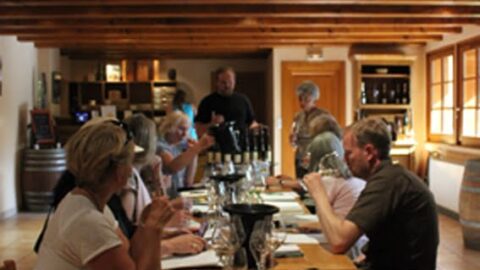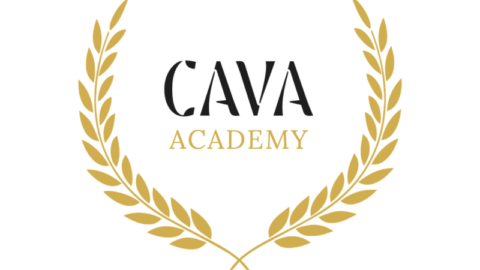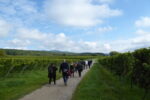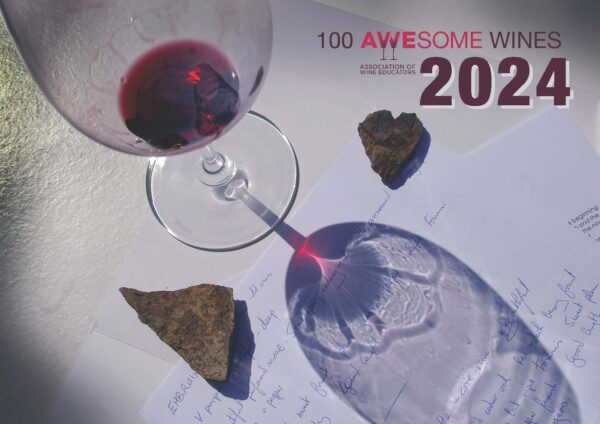July 2015-Thursday 9th July, Lunchtime…We depart the heart of Haut-Rhin for the Vosges mountains and La Vallée de Munster, Gunsbach, the home of Albert Schweitzer. Our destination: La Maison du Fromage
Hosted by Mme Dominique SCHOENHEITZ, a cheese-and-wine pairing exercise. Incorporating her domaine’s wines and local cheeses and charcuterie, Mme Schoenheitz led us through a most informative tasting.
A bit of background and history…
Granite-origin flint soils predominate but there are also pink and yellow sandstones, folding slopes and rich grassy valleys. This region is home to sleepy cows and, on the upper slopes, energetic sheep. Almost no wine, but plenty of snow for Alpine skiing and ski du fond. The name ‘Munster’ is a corruption of the Latin ‘monasterium’ and a monastery dedicated to Saint Grégoire has existed in the valley since around 660 AD. From 1237, and indeed today, the valley is also known as Val St Grégoire.
It’s a fact that crossing a river is simpler than to traverse mountains, thus the fate of Alsace. Alsace, including Munster, was ravaged by the Thirty Years War (1618-1648), was annexed to Germany in 1871, and was the front line during the Great War (1914-1918). At the Treaty of Versailles, Alsace transferred back to France. From June 1940-February 1945 it was occupied yet again by the Germans, but after the War, it returned to France.
Nowadays the Munster valley is verdant hillsides for cows and sheep, artisanal cheesemaking, a bit of craft wool and woodworking and tourism.
Tasting-lunch…
2014 Pinot Blanc Val Saint Grégoire
In fact, Auxerrois
Pale lemon green hue; fresh with lemon-lime aromas, floral overlay; greengage fruit and creamy custard palate with bright acidity, light body. Some length. Fairly simple, but easy-drinking. *+
Munster blanc
A soft cow’s milk cheese, with merely 4 days of maturation, turned and washed with salt daily. Often served with Sylvaner or Pinot Blanc. Used in Alsace as one might a soft Grecian feta. Soft and creamy, lightly lemon, tender, almost like slightly salty crème fraiche in flavour but pressed into shape. Fine with the Pinot Blanc **; disastrous with the 2012 Riesling Linsenberg, which had too much acidity and killed the cheese, making the cheese metallic.↓ ↓ 2008 Riesling Linsenberg only marginally better, the cheese made the wine bitter. ↓ [Note to self, never serve Riesling with soft goat’s cheeses?]
2012 Riesling Linsenberg
decomposed granite soil with many flints
Pale lemon-green colour; pretty aromas of white flowers supporting green apple and white peach; pure definition of flavour, racy acidity, delicate but intense concentration, very long. ***
Fresh Goats Cheese Val de Munster
A semi-soft goat’s milk cheese with quite sharp acidity and a hint of blanched almond nuttiness. Good rind texture and flavour. High acidity in the cheese makes the wine seem sweeter. ** Good match with the youthful Riesling. ** Also a fair match with Pinot Gris *+ but almost too much flavour for the Pinot Blanc.–
2008 Riesling Linsenberg
Pale gold hue; peach and orange blossom, hint of petrol; off-dry, mid-weight, very nice balance of flavour, sugar and acidity. Mineral nuance, custard, waxy texture, good concentration and fair length. **+
Dry Goat’s Cheese Val de Munster
A mature goat’s cheese. With ageing, cheese becomes drier, saltiness becomes more pronounced. A bit hard, but very nice balance between saltiness and roasted cashew nuttiness. Very good example of its type. Wine well-matched with the cheese’s maturity and the wine’s intestinal fortitude. ** Fair match with Pinot Gris. *+
2010 Pinot Gris Linsenberg
Pale lemon, green lights; earthy aromas, ripe fruit, yellow plums and peach, intense, spice note; off-dry with depth, richness, moderate acidity, full-weight and fair length. **+
Barikas
A cow’s milk cheese, which is regularly turned, pressed and aged for around 5-6 months. Quite dense in texture, but with enough ‘give’. Delicate hazelnut flavour with cooked custard underlay. Excellent flavour and texture balance. Delicious wine. *** Excellent match with the Pinot Gris. *** Yum!
Interlude
Mme Schoenheitz commented that Pinot Gris is amongst the best wines to choose for cheese. And proven by Pinot Gris working nicely with the Munster cheeses, especially Munster affiné.
2012 Gewurztraminer Holder
Very pale gold hue; packed with rose petals, lychees and mango, Indian spice note; powerful, ripe palate with decent acidity and spiciness, full weight and good length. A classic example of Alsace Gewurz. **++ Acceptable with the fresh goat’s cheese.– Poor with aged goat’s cheese. ↓
Munster affiné
A cow’ milk cheese, turned and salted for 3-4 weeks. Not pressed, merely drained and turned. A little bit of maturity in the cheese, but not too much. Worked well with Gerwurz **, fairly well with the aged 2008 Riesling *+ and with Pinot Gris **.
..and then there was meat…
2013 Pinot Noir Cuvée St Grégoire
Very pale cherry hue; pure red and black cherry, hint of pain d’épices, aromatic nose; delicate style, gentle tannins, good freshness, herbes de provence accent, fair varietal definition and length. *+
Selection of local meats
Pinot Noir was very nice with the local charcuterie; the bright acidity cutting through the fat and aspic. **+
Pinot Gris also worked with the charcuterie; its weight and richness as a complement to the meats. **
Revelation
Pinot Noir was a near-disaster with almost all the cheeses. Nearly worked with the Munster affiné. * Horrible with the barrikas.↓↓
Do not even consider the soft Munster, or the soft goat’s cheese with red wine-the worst match of the day. ↓↓↓↓ The cheeses died and the wine tasted like it had one of those TCA (or other anisoles) that we abhor.
What did we learn?
White wines with these cheeses is far preferable, but not all white wines work equally well with all cheeses. Alsace Pinot Gris proved a good choice.
Patricia Stefanowicz MW
Tags: Alsace Food and Wine Gewurztraminer Pinot Gris Pinot Noir Riesling







